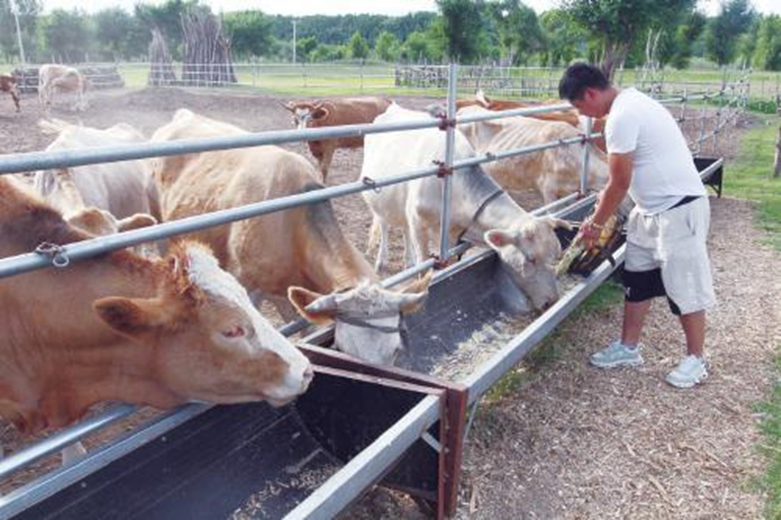Ruminant, a blue ocean to be cultivated
In 2021, the total output of industrial feed in China will exceed 290 million tons, with pig feed accounting for 44.6%, poultry feed accounting for 41.4%, and ruminant feed such as cattle and sheep accounting for only 5%. The proportion of 5% is very low, but it brings unlimited imagination to the ruminant industry. With the growth of domestic consumption of beef, mutton and milk, the scale of ruminant breeding in China is becoming larger and larger, and the domestic industrial feed output is far lower than the standardized breeding demand, so the market space of ruminant is very broad.

Three parts of the world are expected to match pig feed and poultry feed
In recent years, the market for pig feed and poultry feed has become saturated, while ruminant feed is a blue ocean that has not been fully developed. Liang Haijun, deputy secretary-general of China Feed Industry Association, introduced that in the past 10 years, China's output of ruminant feed has increased from 7.75 million tons in 2011 to 14.8 million tons in 2021, with a cumulative growth of 91%, 29 percentage points higher than the average cumulative growth of feed products. In the first half of this year, due to factors such as deferred high feed raw material prices, feed production showed a downward trend, while ruminant output rose against the trend, with a year-on-year growth of 2.8%.
"At present, the output of industrial feed in China is far lower than the demand for standardized breeding, and the household rate of formulated feed for cattle and sheep is only 35%." Huang Qingsheng, director of the feed and forage department of the Animal Husbandry and Veterinary Bureau of the Ministry of Agriculture and Rural Areas, said. This means that ruminant still has great growth potential in the future.
The fundamental driving force for the growth of ruminant is the growth of demand for livestock products. Huang Qingsheng said that according to calculation, the peak consumption of meat and milk per capita in China can reach 75.7 kg and 59 kg respectively, while in 2021, the figure will be 69.6 kg and 42.5 kg respectively, which still has certain consumption growth potential.
With the vigorous consumption, the production of beef, mutton and dairy products in China is also growing steadily, but still can not fully meet the demand. It is understood that in 2021, China's beef imports will be 2.33 million tons, with a self-sufficiency rate of 75%. The dairy imports will increase significantly, with a self-sufficiency rate of only 62.8%.
The blue ocean of ruminant is as wide as the production space of ruminant products is.
"In the future, ruminant feed is expected to be divided into pig feed and poultry feed." Zheng Wenge, president of Henan Feed Industry Association and chairman of Henan Yiwan Zhongyuan Biotechnology Co., Ltd., said. This represents the general confidence of insiders in the future development of ruminant.
Large agricultural and animal husbandry enterprises have joined in one after another, and small and medium-sized enterprises still have many opportunities for development.
Seeking grass and trees to expand the source of feed raw materials
The breeding of ruminants such as cattle and sheep is different from that of pigs and poultry. It requires not only refined feed such as corn and soybean meal, but also coarse feed such as hay and straw.
With the increase of cattle and sheep breeding, the shortage of coarse fodder is becoming increasingly obvious, and the import quantity and price of hay are soaring. How to develop and utilize more roughage resources has become the direction being explored by the ruminant industry. In recent two years, peanut seedlings are becoming an important source of roughage for local cattle and sheep.
"Peanut seedling is rich in crude protein, crude fat, various minerals and vitamins. It is soft, palatable, high digestibility, and cheap. It is a high-quality roughage resource." Fu Tong, professor of Henan Agricultural University and vice president of the College of Animal Science and Technology, said.
As one of the main economic crops in China, peanut planting area is growing steadily with the adjustment of agricultural planting structure, reaching about 70 million mu in 2020. As the largest peanut production province in China, Henan has a planting area of more than 17 million mu and a peanut straw output of 3.4-5.1 million tons.
Peanut seedling, as a coarse fodder resource, has great potential for development. It is understood that due to the loss and mildew in harvesting, processing and storage, the feed utilization rate of peanut seedlings is less than 50%.
Peanut seedlings have alleviated the problem of shortage of coarse fodder, which also reflects that the current gap is still large. According to the "Fourteenth Five Year Plan" National Forage Industry Development Plan, to achieve the goal of self-sufficiency rate of beef, mutton and milk, there is still a gap of nearly 50 million tons of high-quality forage.
In addition to the use of peanut seedlings and other herbal resources, the industry also pays attention to the development of woody resources. According to associate professor and Li Wen of China Agricultural University, mulberry leaves, broussonetia papyrifera and other woody resources have high crude protein content and rich nutrition. After proper processing, they can also become relatively high-quality roughage and expand the source of ruminant feed in China.
At present, there are still many problems in the field of ruminant which need to be tackled urgently. Yao Bin said that rumen roughage digestibility and high concentrate feeding mode led to rumen health, feed waste and mycotoxin pollution caused by methane emission, which are all problems that need to be solved urgently in the ruminant feed industry.


